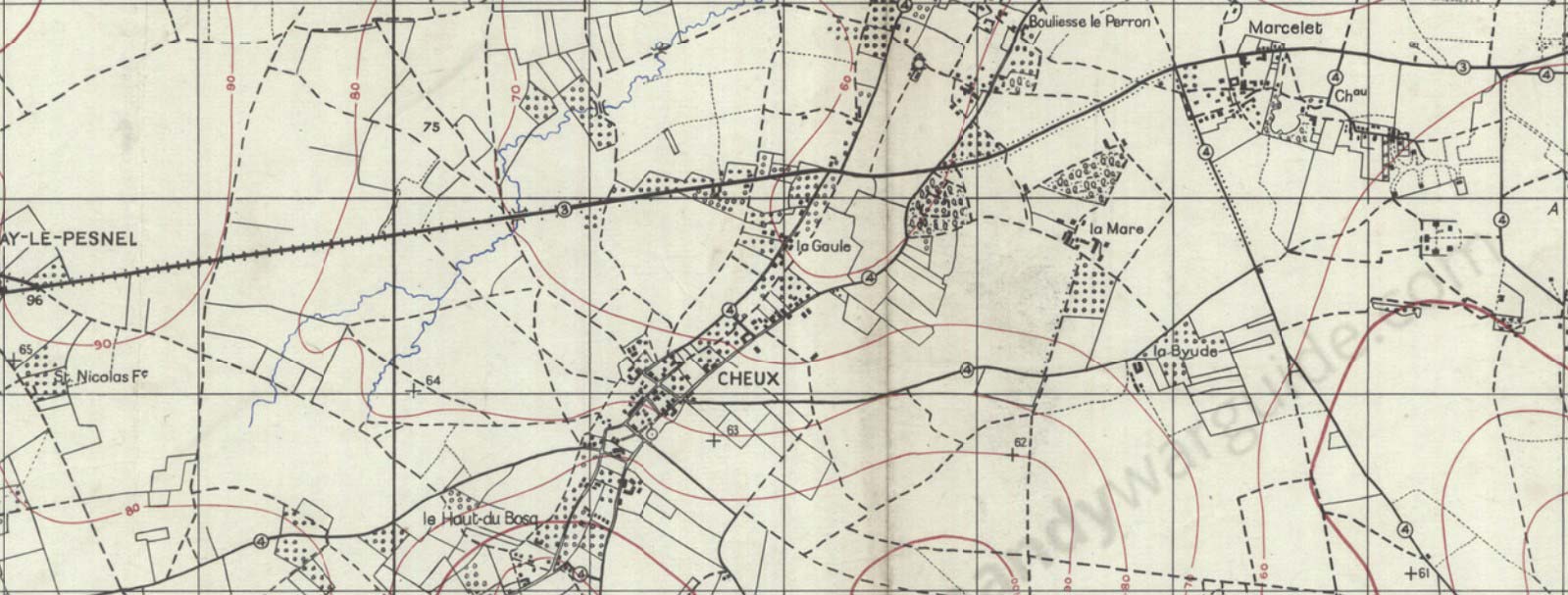6 German Panther Tanks Destroyed In Battle With Duke of Cornwall's Light Infantry Division
On the 27th of June 1944 in their first combat experience since arriving in Normandy the men of 5th Duke of Cornwall’s Light Infantry were involved in a battle with 6 German Panther Tanks. Despite casualties in their gun crews and the death of their Colonel, using anti-tank guns and PIATs 5 of the tanks were destroyed and the 6th was badly damaged.
At 1200 hrs on the 26th June the battalion was given the order to be at 30 minutes notice to move to relieve a unit in the line.
It was late in the night before the Battalion was actually called to relieve the 9th Cameronians in the area of Chuex, a small village about 5 km to the West of Caen. The battalion did not move off until 0130 hrs on the 27th. The weather was exceptionally bad that night requiring the cycle Company to leave their bikes behind and march due to the state of the road.
 GSGS 4347 Map 37/16 S.E. Cheux
GSGS 4347 Map 37/16 S.E. Cheux
It was dawn when the Battalion relieved the 9th Cameronians in an orchard to the south of Cheux. Arthur Jones of B Company recalled that when they arrived at the orchard there was a small group of people huddled in the corner when asked if they were the platoon they had been sent to relieve, they replied that they were in fact all that was left of a Company.
The Cameronians withdrew and the 5th Duke of Cornwall’s Light Infantry started occupying the little trenches and ditches surrounding the orchard. A short distance from the orchard a battle could be heard involving a lot of tank and small arms fire.
All of a sudden tanks started to rumble up a sunken lane 50-100 yards behind them, initially, they thought they were their own tanks. But they were in fact 6 German Panther tanks which had moved back up from the flank and come around behind them.
The tanks travelled down the sunken lane towards the orchard where Major J. Fry had just set up his Company Headquarters. Three tanks entered the orchard through the hedges causing heavy casualties, Captain Jobson sent quickly for the PIATs located nearby.
Sergeant Hicks collected a PIAT gun and dashed to attack the first tank single-handed firing the first PIAT from 100 yards obtaining a hit. Despite being slightly wounded by the tanks Besa gun, he closed to within 60 yards of the tank and scored two more hits before finally crippling the tank from 10 to 15 yards. The crew being wounded abandoned the crippled tank and scattered. Major Fry and Captain Jobson each killed a German dispatch rider with their rifles.
During this time a second tank was stalked by Captain Blackwell who was unseen by the tank crew and managed to get to within 10 yards of the tank before disabling it with a PIAT. The attack by the infantry against the tanks helped to confuse the Germans and gave the anti-tank gun crew precious time to prepare with Captain Jobson saying “This was of tremendous value to our anti-tank gunners in the rear, giving them precious time in which to deal with the enemy”
While the attack was taking place in the orchard the platoon of anti-tank gunners were still bringing their gun into position a quarter of a mile to the rear when they received a warning of enemy tanks to the rear. As soon as the gun was traversed to face the attack Sergeant J. Willson the gun detachment commander heard his platoon commander Capt R.P. Varcoe shout “Tanks to your front Sergeant - Engage!”
With four of their six-man crew already wounded Sergeant Willson and his loader, Private Elliot traversed the gun to engage the tanks creeping through the orchard. As they were traversing the gun the attacking tanks opened fire on their position. Sergeant Willson fired off two rounds before he was wounded, the second NCO Corporal R. Brice immediately replacing him.
Corporal Brice and Private Elliot then proceeded to knock out all 3 tanks at a range of approximately 400 yards, firing only eleven rounds. It was during this action that Lieutenant Colonel J.W. Atherton who had jumped in to replace a casualty was killed while assisting to load the gun.
Private Elliot later said in an interview “It was a terrific scrap. The tanks were difficult targets as they were coming towards us and were partly hidden in the trees. But we got them, one after the other, at about four hundred yards range. I saw one tank blow up. It was actually the first time I had seen a German tank.”
The Battalion's exploits in their first day of action in Normandy were covered in the unit's news sheet the “Wyvern News” (No.21 Sunday 16th July) in the article “Tank Killing Is Big News” about the 39 German Tanks and SP Guns which had been destroyed by units of the 43rd (Wessex) Infantry Division during their first fortnight in the line.
“We were given a grand start by the Infantry Battalion which destroyed five out of six Panthers in its first action just south of CHEUX on June 27. That story was broadcast by the B.B.C. and is expected to be published widely in the Press this week.”
By the end of the battle, the battalion has knocked out 5 Pather tanks and a 6th was overturned in a ditch. Lieutenant Colonel J.W. Atherton, Captain P.E.G. Coode and 13 other ranks were killed. Lieutenant K.W. Gilbert, Lieutenant C.G. Hopkins and a further 23 other ranks were wounded and 1 other rank missing.
Today Lieutenant Colonel Atherton, Captain Coode and other men of the 5th Duke of Cornwall’s Light Infantry from that battle are buried at Bayeux War Cemetery.